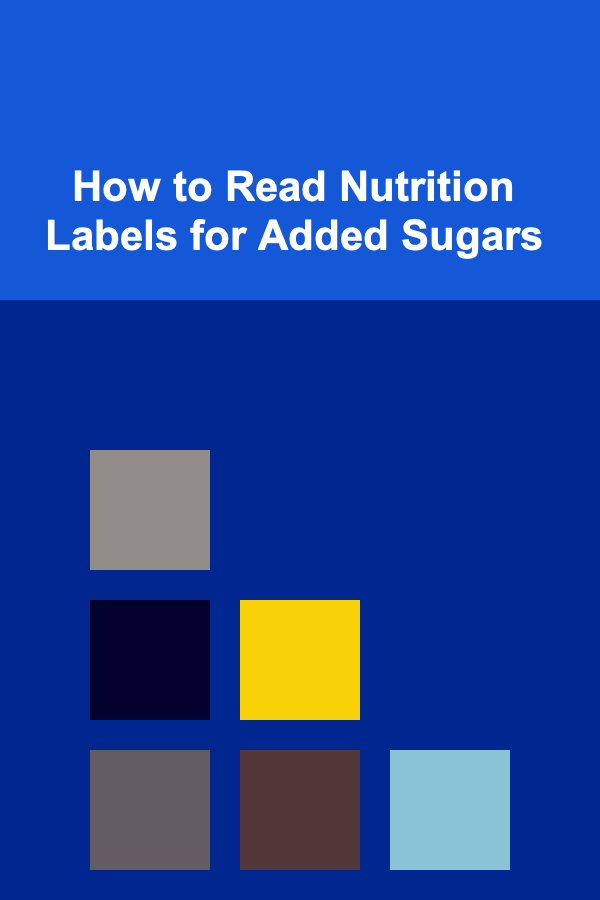
How to Read Nutrition Labels for Added Sugars
ebook include PDF & Audio bundle (Micro Guide)
$12.99$9.99
Limited Time Offer! Order within the next:

In today's world, where health-consciousness is on the rise, understanding nutrition labels has become more important than ever. Among the most important things to pay attention to are the sugars listed in the ingredient list and the nutrition facts. Sugar consumption, particularly added sugars, is a significant contributor to numerous health issues such as obesity, diabetes, heart disease, and even cancer. In this article, we will explore how to read nutrition labels for added sugars, understand their impact on health, and learn how to make informed choices when purchasing food.
What Are Added Sugars?
Before diving into reading nutrition labels, it is important to first understand what added sugars are. Added sugars refer to sugars that are incorporated into foods during processing or preparation. These sugars are different from naturally occurring sugars found in whole foods like fruits, vegetables, and dairy products. While natural sugars come with fiber, vitamins, and minerals, added sugars are often found in processed foods and are typically devoid of beneficial nutrients.
Some common examples of added sugars include:
- Table sugar (sucrose)
- High fructose corn syrup (HFCS)
- Honey
- Maple syrup
- Agave nectar
- Molasses
- Brown sugar
- Artificial sweeteners in some products
The American Heart Association (AHA) recommends that women limit their intake of added sugars to no more than 6 teaspoons (25 grams) per day, while men should aim for no more than 9 teaspoons (38 grams) per day. However, most people consume far more than this, contributing to various chronic health conditions.
Why is it Important to Track Added Sugars?
Understanding the importance of limiting added sugars in your diet can help you make better nutritional choices. Excessive consumption of added sugars is linked to a variety of serious health problems, including:
1. Obesity
- Consuming too many added sugars contributes to excess calorie intake without providing any nutritional value. This can lead to weight gain and, over time, obesity.
2. Diabetes
- A diet high in added sugars can lead to insulin resistance, which is a precursor to type 2 diabetes. High sugar intake can cause frequent spikes in blood sugar, putting strain on the pancreas and eventually impairing insulin production.
3. Heart Disease
- Studies have shown that excessive sugar intake is linked to an increased risk of heart disease. High sugar consumption can lead to high blood pressure, inflammation, and elevated triglycerides, all of which are risk factors for heart disease.
4. Tooth Decay
- Added sugars provide a food source for harmful bacteria in the mouth, leading to cavities and other dental issues.
5. Liver Damage
- Excess sugar, particularly fructose, is processed by the liver. Overloading the liver with sugar can lead to non-alcoholic fatty liver disease (NAFLD), a condition that can damage liver function.
6. Increased Risk of Cancer
- Some studies suggest that high sugar intake may increase the risk of certain cancers. Although the research is ongoing, it is believed that high sugar levels contribute to chronic inflammation and insulin resistance, both of which are risk factors for cancer.
Understanding Nutrition Labels
Now that we understand the importance of added sugars, let's delve into how to read nutrition labels. Nutrition labels on packaged foods can be a wealth of information, but understanding them can be overwhelming, especially with all the jargon and numbers. Here is a breakdown of how to navigate nutrition labels with a focus on added sugars.
1. The Serving Size
The serving size is the first piece of information you will see on the label. It is important to note that all the nutritional values listed are based on this serving size. Many people make the mistake of assuming that the nutritional information applies to the entire package, but in reality, you need to calculate it based on the serving size.
For example, if the serving size is 1 cup, but you consume 2 cups, you are effectively consuming double the listed nutritional values, including added sugars.
2. Total Sugars
Total sugars refer to the sum of both naturally occurring sugars and added sugars. Naturally occurring sugars are those found in whole foods, such as fruits and milk, while added sugars are those that are included during the processing or preparation of food.
For instance, in a cup of yogurt, the total sugar content may include natural sugars from the milk as well as any added sugars (such as sweeteners or flavorings). While it's important to understand total sugars, the key is to focus on the breakdown of added sugars, as they contribute to the negative health effects mentioned earlier.
3. Added Sugars
On the updated nutrition labels, you will notice a line that specifically states the amount of "added sugars." This is the key figure to focus on when reading the label. The added sugars amount reflects the sugars that have been included in the product during manufacturing and does not include sugars found naturally in foods like fruits or dairy.
For example, if you are looking at a granola bar, the label might show 20 grams of total sugar, but only 10 grams of that may be added sugars. This means half of the sugars are naturally occurring from the oats or other ingredients, while the other half are sweeteners added during production.
4. Percent Daily Value (%DV)
The %DV for added sugars tells you how much a serving of the food contributes to the recommended daily limit of added sugar intake, based on a 2,000-calorie diet. The American Heart Association recommends limiting added sugar intake to 25 grams (6 teaspoons) for women and 38 grams (9 teaspoons) for men.
For example, if a product contains 20 grams of added sugars and the %DV is 33%, this means that one serving of this product provides 33% of the recommended daily intake of added sugars. A high %DV, particularly above 20%, is an indication that the food contains a significant amount of added sugars.
5. Other Key Nutrients
While looking at added sugars is crucial, it's also important to consider other aspects of the food's nutritional profile, such as:
- Total Carbohydrates: Total carbohydrates include all types of carbohydrates in the product, including sugars, starches, and fiber. While fiber is beneficial, the sugars included in this number may or may not be added sugars.
- Fat Content: Some foods high in added sugars may also contain unhealthy fats, which can further contribute to negative health outcomes. Trans fats, in particular, should be avoided.
- Protein: Foods that are high in added sugars but lack protein may not be as filling and can lead to overeating.
- Vitamins and Minerals: The presence of micronutrients like calcium, vitamin D, and iron can also help evaluate whether the food item is providing nutritional value beyond the added sugars.
6. Ingredients List
In addition to looking at the nutrition facts panel, the ingredients list on the food label can provide helpful information. Ingredients are listed in order of quantity, with the first ingredient being the most abundant. If sugar or any of its many forms (e.g., corn syrup, high fructose corn syrup, cane sugar, etc.) appear near the top of the list, it indicates that the product contains a significant amount of added sugar.
Many processed foods contain hidden added sugars under different names. For example, you may find syrups, fruit concentrates, or sweeteners such as agave nectar, brown sugar, or dextrose. Being aware of these different names for sugar can help you identify products that are high in added sugars.
How to Make Healthier Choices
Now that you understand how to read nutrition labels for added sugars, the next step is to use that information to make healthier food choices. Here are some tips to help you reduce your intake of added sugars:
1. Choose Whole Foods
Whole foods, such as fruits, vegetables, lean proteins, and whole grains, contain naturally occurring sugars and are typically free of added sugars. These foods provide important nutrients that help keep you full and satisfied without causing blood sugar spikes.
2. Limit Processed Foods
Many processed and packaged foods contain large amounts of added sugars. This includes foods like sodas, candies, breakfast cereals, packaged snacks, and even seemingly "healthy" options like granola bars and flavored yogurts. By limiting processed foods, you can reduce your intake of added sugars.
3. Check for Sugar Alternatives
Some products use sugar alternatives like stevia or monk fruit to reduce added sugar content. While these alternatives may be a healthier option in moderation, it's important to still read labels carefully and be aware of any other ingredients that may contribute to overall calorie intake.
4. Cook at Home
Cooking at home allows you to control exactly what goes into your meals. By preparing meals from scratch, you can avoid unnecessary added sugars found in many restaurant dishes or take-out options.
5. Drink Water or Unsweetened Beverages
Sodas and sugary beverages are some of the biggest culprits in added sugar consumption. Opting for water, herbal teas, or unsweetened beverages can significantly reduce your added sugar intake.
Conclusion
Reading nutrition labels for added sugars is an essential step toward making informed dietary choices. By understanding what added sugars are, recognizing their impact on health, and learning how to read food labels, you can better manage your sugar intake. Being mindful of added sugars will help reduce the risk of chronic diseases like obesity, diabetes, and heart disease, and contribute to a healthier, more balanced lifestyle.

How to Create a Space for Writing and Note-Taking
Read More
How to Evaluate Your File Organization System Regularly
Read More
How to Rotate Your Collection Seasonally for Fresh Inspiration
Read More
How to Use Shelf Risers for Maximizing Space
Read More
How to Use Technology for Smart Dining Room Organization
Read More
How to Understand Art Marketing for Artists
Read MoreOther Products

How to Create a Space for Writing and Note-Taking
Read More
How to Evaluate Your File Organization System Regularly
Read More
How to Rotate Your Collection Seasonally for Fresh Inspiration
Read More
How to Use Shelf Risers for Maximizing Space
Read More
How to Use Technology for Smart Dining Room Organization
Read More